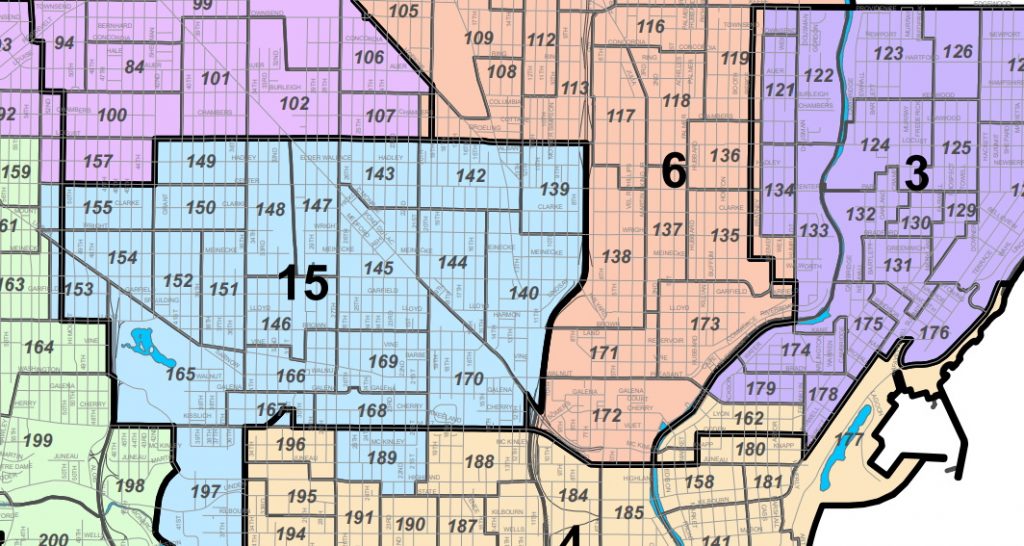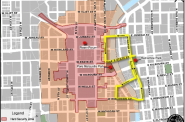Committee Backs City Redistricting Plan
But what about a third Latino majority district?
The proposed plan to redraw all 15 council districts in the city of Milwaukee as part of the once-a-decade redistricting process is encountering no major opposition.
A special meeting of the Judiciary & Legislation Committee Monday to review the districts and accept public comment lasted less than an hour. The committee unanimously recommended the full council adopt the map.
After adopting a ward map last week, a draft of the resulting district map was released on Thursday afternoon. A town hall meeting was held Friday evening to review it.
“A lot of that feedback has been considered by [the Legislative Reference Bureau] and we continue to discuss the impact of applying those suggestions,” said Hamilton.
But no amendments have been formally introduced.
“I am just concerned that while we have a growing Latino population… we haven’t created a third district that has that same voting power,” said Milwaukee Election Commission director Claire Woodall-Vogg, who said she was only giving voice to what was discussed during the town hall. “My job is to administer elections, LRB is the expert at drawing maps.”
Knapp said an effort was made to create a third Latino majority district, but the population distribution doesn’t afford it without redrawing much of the city and even that could have issues.
Ald. Scott Spiker, who represents an area on the far South Side with a growing Latino population, said he attempted to create a Latino third district after seeing the county struggle with a similar discussion. Any district he created diluted the other two majority Latino districts he said, noting that the Latino population in his district is split east and west. “My experience is consistent with what LRB discovered,” he said. But he said he expects a third district by 2030.
City Treasurer Spencer Coggs, a former state legislator, said his political ascendancy was a product of the Voting Rights Act. He said he was appearing to ask if the city was “on the side of the angels,” given that the state process is likely to end up in court.
LRB director Keith Broadnax said he believe the bureau had undertaken a process that represented the city and had political support. “We didn’t take into account where the alders live,” he said, but noted that changes were later made at their recommendations.
“They represent less people, but everything else remains pretty much the same,” said Broadnax.
The city experienced a net population loss (17,611) in the past decade, but in an uneven manner. The result is that districts that lost population, particularly those on the North Side, must expand their footprint while others must contract.
The resulting districts would maintain the balance of six Black majority districts, two Hispanic districts and six white districts of which are two are being described as Hispanic “influence” districts. There is no legal definition for an “influence” district.
Spiker’s southside district, the 13th, and the one to the north, the 14th represented by Alderwoman Marina Dimitrijevic, would have voting-age Hispanic populations of 25.6% and 28.1% respectively. Their white voting-age populations are 57.4% and 62.4%.
By voting age population, one district has no racial or ethnic majority. The fifth aldermanic district, currently represented by Ald. Nikiya Dodd, would be 44% white and 43% Black based on the voting-age population.
The 10th district, represented by Ald. Michael Murphy, is 55.2% white, 28.4% Black and 9.4% Hispanic by voting-age population.
“We can say that segregation has helped shape some of these maps, just based on the hyper segregation that exists within the city,” said Hamilton.
The only resident opposition to the districts came from a Tri-Block neighborhood resident Carol Darrington who asked that the area not be divided.
Murphy, who represents the 10th district, said that’s a result of having to draw ward boundaries under state law with between 1,000 to 4,000 residents. The boundaries of the adjoining wards were changed to add population to the otherwise declining seventh district, represented by Ald. Khalif Rainey.
“I would rather not see any of my district change,” said Murphy. “I think every alderman feels that way.”
Murphy and Hamilton both said they thought having more time for residents to study and interact with the maps would have improved the process.
The full council is scheduled to vote on the map Tuesday, Nov. 23. There is no public hearing scheduled as part of that vote.
The new district map would go into effect for the 2024 spring elections for all 15 council seats. Any special election occurring before that time, under state law, would occur with new wards under the 2011 districts. The election commission would need to accommodate or restrict voters in the new, redrawn wards so that those voting align with those eligible under the prior districts.
Maps and Statistics
- Proposed Distrct Map – Detailed
- Proposed District Map – 11×17
- Proposed District Map Demographics
- Adopted 2021 City Ward Map
- 2012 Ward Map
- 2012 Common Council Districts
- 2000 to 2010 Population Change by Aldermanic District
- 2010 to 2020 Population Change by Aldermanic District
- 2020 Population Change by Wards
- 2020 Aldermanic District Demographics
Legislation Link - Urban Milwaukee members see direct links to legislation mentioned in this article. Join today
If you think stories like this are important, become a member of Urban Milwaukee and help support real, independent journalism. Plus you get some cool added benefits.
Related Legislation: File 211137
More about the Milwaukee County redistricting process
- Op Ed: Muslim Community Needs Representation - Janan Najeeb - Jan 29th, 2022
- City Hall: Council Ends Redistricting With Anger, Tears - Jeramey Jannene - Jan 18th, 2022
- Statement from Milwaukee Mayor Cavalier Johnson - Mayor Cavalier Johnson - Jan 18th, 2022
- City Hall: Latino Leaders Could Sue Over Redistricting - Jeramey Jannene - Jan 14th, 2022
- Latinx Leaders Condemn Common Council’s Refusal to Draw New Districts Reflecting Dramatic Growth of Latinx Population; Demand Second Legal Opinion - Voces de la Frontera - Jan 14th, 2022
- Voces de la Frontera Statement on Redistricting Decision - Voces de la Frontera - Jan 11th, 2022
- Statement on redistricting decision - Ald. JoCasta Zamarripa - Jan 10th, 2022
- City Hall: Milwaukee Starts Over On Redistricting, Only To Adopt Same Map Again - Jeramey Jannene - Jan 10th, 2022
- Statement by Milwaukee Mayor Tom Barrett: - Mayor Tom Barrett - Dec 14th, 2021
- City Hall: Council Halts Redistricting After Latino Pushback - Jeramey Jannene - Dec 14th, 2021
Read more about Milwaukee County redistricting process here
Political Contributions Tracker
Displaying political contributions between people mentioned in this story. Learn more.
- December 31, 2019 - Marina Dimitrijevic received $50 from Nikiya Dodd
- January 13, 2016 - Ashanti Hamilton received $20 from Nikiya Dodd






















Why would we decide any of this based on the color of peoples skin? Is that not the very definition of racism.